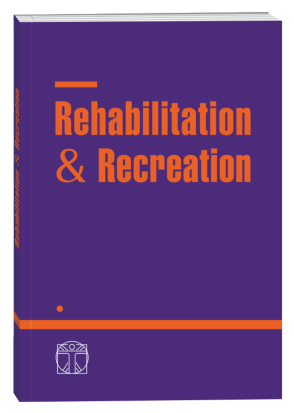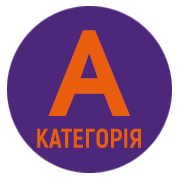ЗДОРОВ’Я ТА РУХОВА АКТИВНІСТЬ УКРАЇНЦІВ ПІД ЧАС ПОВНОМАСШТАБНОЇ ВІЙНИ З РОСІЄЮ
DOI:
https://doi.org/10.32782/2522-1795.2024.18.3.14Słowa kluczowe:
фізичне здоров’я, психічне здоров’я, рухова активність, стрес, депресія, ПТСР, біль, війнаAbstrakt
Мета – дослідити вплив воєнних подій в Україні на здоров’я та рухову активність населення. Матеріал. Опитування проведено у 2023 році у два етапи. У дослідженні взяли участь 572 респонденти, для аналізу даних використані результати 394 опитувальників. Серед респондентів – 311 жінок і 84 чоловіки віком від 18 до 76 років (середній вік – 35,2±13,0 року). 66,2% опитаних на момент опитування були в Україні, з них 9,9% – внутрішньо переміщені особи, 33,8% опитаних перебували за межами України. Дослідження включало методи для визначення симптомів ПТСР, депресії, сприйняття стресу, стресостійкості, рівня болю, порушення сну, рівня рухової активності, фізичної підготовленості та загальний опитувальник факторів впливу. Результати. Аналіз розподілу учасників за різними критеріями у абсолютних та відносних величинах дозволив визначити рівень фізичного та психічного здоров’я українців. Симптоми ПТСР та депресії частіше проявляються у жінок. Через 1,5 року повномаштабної війни симптоми ПТСР та депресії, стійкість до стресу знизились, але сприйняття стресу збільшилось. Після початку повномасштабної війни більше половини українців зазначили, що мають проблеми зі сном, частіше почали проявлятися панічні атаки, збільшилась кількість як гострих респіраторних, так і хронічних захворювань. Українці частіше почали відчувати біль у різних частинах тіла, хоча через 1,5 року після початку повномасштабної війни біль перейшов у більшості у хронічну форму. Висновки. Загальний стан як фізичного, так і ментального здоров’я українців значно погіршився після початку повномасштабної війни Росії проти України. Цей вплив є взаємозалежним, тому в наступній статті ми розглянемо вплив стресу, спричиненого війною, на здоров’я та рухову активність українців.
Bibliografia
ACAPS Analysis Hub. (2023). Ukraine: Impact of the conflict on the health care system and focus on specific needs. Retrieved from: www.acaps.org/fileadmin/Data_Product/Additional_resources/20231004_ACAPS_thematic_report_Ukraine_impact_of_the_conflict_on_healthcare_system_and_spotlight_on_specific_needs_Ukrainian.pdf [in Ukrainian].
Anjum G., Aziz M., & Hamid H.K. (2023). Life and mental health in limbo of the Ukraine war: How can helpers assist civilians, asylum seekers and refugees affected by the war? Front Psychol, 14, 1129299. https://doi.org/10.3389/fpsyg.2023.1129299.
Ashbaugh A.R., Houle-Johnson S., Herbert C., El-Hage W., & Brunet A. (2016). Psychometric Validation of the English and French Versions of the Posttraumatic Stress Disorder Checklist for DSM-5 (PCL-5). Plos One, 11(10), e0161645. https://doi.org/10.1371/journal.pone.0161645.
Bastien C.H., Vallieres A., & Morin C.M. (2001). Validation of the Insomnia Severity Index as an outcome measure for insomnia research. Sleep Medicine, 2(4), 297–307. https://doi.org/10.1016/S1389-9457(00)00065-4.
Bezsheiko V. (2016). Adaptation of the scale for the clinical diagnosis of PTSD and the questionnaire “List of symptoms of PTSD” for the Ukrainian population. Psychosomatic Medicine and General Practice, 1(1), e010108. Retrieved from: https://uk.e-medjournal.com/index.php/psp/article/view/8 [in Ukrainian].
Blackwell T.L., & McDermott A.N. (2014). Test Review: Patient Health Questionnaire-9 (PHQ-9). Rehabilitation Counseling Bulletin, 57(4), 246–248. https://doi.org/10.1177/0034355213515305.
Coelho G.L.D., Hanel P.H.P., Cavalcanti T.M., Rezende A.T., & Gouveia V.V. (2016). Brief Resilience Scale: Testing its factorial structure and invariance in Brazil. Universitas Psychologica, 15(2). https://doi.org/10.11144/Javeriana.upsy15-2.brst
Comer R.J., & Comer J.S. (2021). Abnormal psychology. 11th edition. Worth Publishers.
Costantini L., Pasquarella C., Odone A., Colucci M.E., Costanza A., Serafini, G., Aguglia A., Belvederi Murri M., Brakoulias V., Amore M., Ghaemi S.N., & Amerio A. (2021). Screening for depression in primary care with Patient Health Questionnaire-9 (PHQ-9): A systematic review. J Affect Disord, 279, 473–483. https://doi.org/10.1016/j.jad.2020.09.131.
Dzhus M., & Golovach I. (2022). Impact of Ukrainian-Russian War on Health Care and Humanitarian Crisis. Disaster Med Public Health Prep, 17, e340. https://doi.org/10.1017/dmp.2022.265.
Fetzner M.G., & Asmundson G.J. (2015). Aerobic Exercise Reduces Symptoms of Posttraumatic Stress Disorder: A Randomized Controlled Trial. Cogn Behav Ther, 44(4), 301–313. https://doi.org/10.1080/16506073.2014.916745.
IDF. (2021). Diabetes in Ukraine. Retrieved from: https://idf.org/europe/ournetwork/our-members/ukraine/.
IOM UN Migration (2023). Ukraine internal displacement report – R15 December 2023. Retrieved from: https://dtm.iom.int/reports/ukraine-returns-report-general-populationsurvey-round-15-november-december-2023.
Ito M., Takebayashi Y., Suzuki Y., & Horikoshi M. (2019). Posttraumatic stress disorder checklist for DSM-5: Psychometric properties in a Japanese population. Journal of Affective Disorders, 247, 11–19. https://doi.org/10.1016/j.jad.2018.12.086.
Jawaid A., Gomolka M., & Timmer A. (2022). Neuroscience of trauma and the Russian invasion of Ukraine. Nat Hum Behav, 6(6), 748–749. https://doi.org/10.1038/s41562-022-01344-4.
Jensen M.P., Chen C., & Brugger A.M. (2003). Interpretation of visual analog scale ratings and change scores: a reanalysis of two clinical trials of postoperative pain. J Pain, 4(7), 407–414. https://doi.org/10.1016/s1526-5900(03)00716-8.
Kiro L., Zak M., & Chernyshov O. (2023). Structure and dynamics of the course of chronic non-infectious somatic diseases in patients during war events on the territory of Ukraine. BMC Public Health, 23(1), 1464. https://doi.org/10.1186/s12889-023-16394-0.
Konaszewski K., Niesiobedzka M., & Surzykiewicz J. (2020). Validation of the Polish version of the Brief Resilience Scale (BRS). Plos One, 15(8), e0237038. https://doi.org/10.1371/journal.pone.0237038.
Lewtak K., Kanecki K., Tyszko P., Gorynski P., Kosinska I., Poznanska A., Rzad M., & Nitsch-Osuch A. (2022). Hospitalizations of Ukrainian Migrants and Refugees in Poland in the Time of the Russia-Ukraine Conflict. Int J Environ Res Public Health, 19(20). https://doi.org/10.3390/ijerph192013350.
Maddah D., Salvi C., Vadi R., & Mohammad M. (2022). Risk Communication and Community Engagement in Action During Ukraine’s War. Ann Glob Health, 88(1), 102. https://doi.org/10.5334/aogh.3937.
Martinez-Calderon J., Villar-Alises O., Garcia-Munoz C., Pineda-Escobar S., & Matias Soto J. (2024). Multimodal exercise programs may improve posttraumatic stress disorders symptoms and quality of life in adults with PTSD: An overview of systematic reviews with metaanalysis. Clin Rehabil, 2692155231225466. https://doi.org/10.1177/02692155231225466.
Mendoza-Munoz M., Adsuar J.C., Mendoza-Munoz D.M., Polero P., & Carlos-Vivas J. (2021). Concurrent Validity and Reliability of a Novel Visual Analogue Fitness Perception Scale for Adolescents (FP VAS A). Int J Environ Res Public Health, 18(7). https://doi.org/10.3390/ijerph18073457.
Ministry of Health of Ukraine. (2024, 05.02.2024). Losses of the medical system for more than 23 months of the war: Russia damaged 1.523 medical facilities and completely destroyed another 195. Retrieved from: https://moz.gov.ua/article/news/vtrati-medichnoi-sistemi-zaponad-23-misjaci-vijni-rosija-poshkodila-1523-ob%e2%80%99ekti-medzakladiv-ta-sche-195-zrujnuvala-vschent- [in Ukrainian].
National demographic forecasts. (2023). Retrieved from: https://www.idss.org.ua/forecasts/nation_pop_proj [in Ukrainian].
Nikitina I.M., Favor T.A., Wireko A.A., Sinkina A.A., Babar T.V., Herasymenko S.F., Toufik A.-R. (2023). Stress-induced menstrual disorders in adolescents during the Ukrainian war: cross-sectional study. Ann Med Surg (Lond), 85(7), 3428–3433. https://doi.org/10.1097/MS9.0000000000000974.
Pandey A., Wells C.R., Stadnytskyi V., Moghadas S.M., Marathe M.V., Sah P., Crystal W., Meyers L.A., Singer B.H., Nesterova O., & Galvani A.P. (2023). Disease burden among Ukrainians forcibly displaced by the 2022 Russian invasion. Proceedings of the National Academy of Sciences of the United States of America, 120(8). https://doi.org/10.1073/pnas.2215424120.
Parente P., Melnyk A., Lombardo P., Villani L., Grossi A., Goletti M., Barbara A., & Santone G. (2023). Demographic and epidemiological characteristics of Ukrainian refugees in an Italian Local Health Authority. European Journal of Public Health, 33(5), 815–820. https://doi.org/10.1093/eurpub/ckad130
Piotrowicz K., Semeniv S., Kupis R., Rys M., Perera I., Gryglewska B., & Gasowski J. (2022). Disease burden in older Ukrainian refugees of war: a synthetic reanalysis of public records data. Lancet Healthy Longev, 3(10), e667–e673. https://doi.org/10.1016/S2666-7568(22)00187-8.
Rosenbaum S., Sherrington C., & Tiedemann A. (2015). Exercise augmentation compared with usual care for post-traumatic stress disorder: a randomized controlled trial. Acta Psychiatr Scand, 131(5), 350–359. https://doi.org/10.1111/acps.12371.
Sagelv E.H., Hopstock L.A., Johansson J., Hansen B.H., Brage S., Horsch A., Ekelund U., & Morseth B. (2020). Criterion validity of two physical activity and one sedentary time questionnaire against accelerometry in a large cohort of adults and older adults. BMJ Open Sport Exerc Med, 6(1), e000661. https://doi.org/10.1136/bmjsem-2019-000661.
Stinnett G.S., Westphal N.J., & Seasholtz A.F. (2015). Pituitary CRH-binding protein and stress in female mice. Physiology & Behavior, 150, 16–23. https://doi.org/10.1016/j.physbeh.2015.02.050.
Tillmann J., Weckbecker K., Wiesheu P., Bleckwenn M., Deutsch T., & Munster E. (2023). Primary care of Ukrainian refugees. ZFA (Stuttgart), 99(1), 28–33. https://doi.org/10.1007/s44266-022-00001-3.
UkrDzen. (2024). Mapa tryvoh Ukrayiny [Alarm map of Ukraine]. Retrieved from: https://alerts.in.ua/ [in Ukrainian].
UNAIDS. (2022). Ukraine: HIV and AIDS Estimates. Retrieved from: https://www.unaids.org/en/regionscountries/countries/ukraine
Vorobiova A., Schilling R. (2023). The Impacts of War-Induced Stress on the Health and Physical Activity of Ukrainians ECSS Paris 2023 – the 28th Annual Congress of the European College of Sport Science, Paris. DOI: 10.13140/RG.2.2.22219.77600.
Warttig S.L., Forshaw M.J., South J., & White A.K. (2013). New, normative, English-sample data for the Short Form Perceived Stress Scale (PSS-4). J Health Psychol, 18(12), 1617–1628. https://doi.org/10.1177/1359105313508346.
WHO. (2021). World Tuberculosis Day: supporting Ukraine in scaling up TB diagnosis and treatment. Retrieved from: https://www.who.int/europe/news/item/23-03-2021-worldtuberculosis-day-supporting-ukraine-in-scalingup-tb-diagnosis-and-treatment.
WHO. (2024). Surveillance system for attacks on health care. World Health Organization. Retrieved from: https://extranet.who.int/ssa/Index.aspx.
Williamson A., & Hoggart B. (2005). Pain: a review of three commonly used pain rating scales. J Clin Nurs, 14(7), 798–804. https://doi.org/10.1111/j.1365-2702.2005.01121.x.
Windle G., Bennett K.M., & Noyes J. (2011). A methodological review of resilience measurement scales. Health Qual Life Outcomes, 9, 8. https://doi.org/10.1186/1477-7525-9-8.
World Bank (2018). Hypertension care in Ukraine: Breakpoints and Implications for Action 2022. Retrieved from: https://docume n t s 1 . w o r ldban k . o rg / c u r a t e d /en/525041547230842315/pdf/133691-WPPUBLIC-ADD-SERIES-HypertensioninUkrainePolicybriefENGLFINAL.pdf.
Pobrania
Opublikowane
Jak cytować
Numer
Dział
Licencja
Prawa autorskie (c) 2024 A. V. Vorobiova, M. M. Vasylenko, R. Schilling

Utwór dostępny jest na licencji Creative Commons Uznanie autorstwa – Użycie niekomercyjne – Bez utworów zależnych 4.0 Międzynarodowe.












